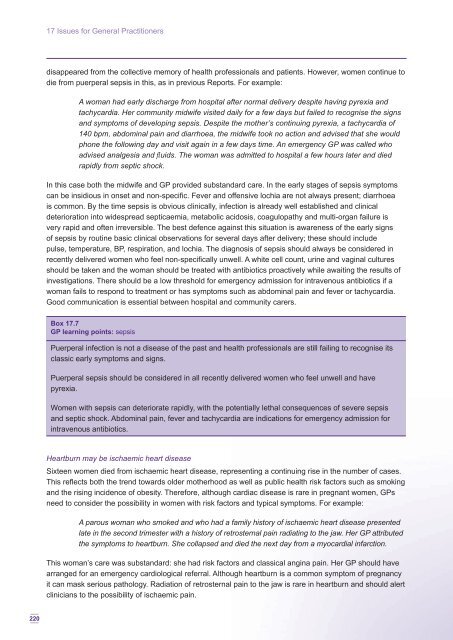Saving Mothers' Lives: - Public Health Agency for Northern Ireland
Saving Mothers' Lives: - Public Health Agency for Northern Ireland
Saving Mothers' Lives: - Public Health Agency for Northern Ireland
You also want an ePaper? Increase the reach of your titles
YUMPU automatically turns print PDFs into web optimized ePapers that Google loves.
220<br />
17 Issues <strong>for</strong> General Practitioners<br />
disappeared from the collective memory of health professionals and patients. However, women continue to<br />
die from puerperal sepsis in this, as in previous Reports. For example:<br />
A woman had early discharge from hospital after normal delivery despite having pyrexia and<br />
tachycardia. Her community midwife visited daily <strong>for</strong> a few days but failed to recognise the signs<br />
and symptoms of developing sepsis. Despite the mother’s continuing pyrexia, a tachycardia of<br />
140 bpm, abdominal pain and diarrhoea, the midwife took no action and advised that she would<br />
phone the following day and visit again in a few days time. An emergency GP was called who<br />
advised analgesia and fl uids. The woman was admitted to hospital a few hours later and died<br />
rapidly from septic shock.<br />
In this case both the midwife and GP provided substandard care. In the early stages of sepsis symptoms<br />
can be insidious in onset and non-specifi c. Fever and offensive lochia are not always present; diarrhoea<br />
is common. By the time sepsis is obvious clinically, infection is already well established and clinical<br />
deterioration into widespread septicaemia, metabolic acidosis, coagulopathy and multi-organ failure is<br />
very rapid and often irreversible. The best defence against this situation is awareness of the early signs<br />
of sepsis by routine basic clinical observations <strong>for</strong> several days after delivery; these should include<br />
pulse, temperature, BP, respiration, and lochia. The diagnosis of sepsis should always be considered in<br />
recently delivered women who feel non-specifi cally unwell. A white cell count, urine and vaginal cultures<br />
should be taken and the woman should be treated with antibiotics proactively while awaiting the results of<br />
investigations. There should be a low threshold <strong>for</strong> emergency admission <strong>for</strong> intravenous antibiotics if a<br />
woman fails to respond to treatment or has symptoms such as abdominal pain and fever or tachycardia.<br />
Good communication is essential between hospital and community carers.<br />
Box 17.7<br />
GP learning points: sepsis<br />
Puerperal infection is not a disease of the past and health professionals are still failing to recognise its<br />
classic early symptoms and signs.<br />
Puerperal sepsis should be considered in all recently delivered women who feel unwell and have<br />
pyrexia.<br />
Women with sepsis can deteriorate rapidly, with the potentially lethal consequences of severe sepsis<br />
and septic shock. Abdominal pain, fever and tachycardia are indications <strong>for</strong> emergency admission <strong>for</strong><br />
intravenous antibiotics.<br />
Heartburn may be ischaemic heart disease<br />
Sixteen women died from ischaemic heart disease, representing a continuing rise in the number of cases.<br />
This refl ects both the trend towards older motherhood as well as public health risk factors such as smoking<br />
and the rising incidence of obesity. There<strong>for</strong>e, although cardiac disease is rare in pregnant women, GPs<br />
need to consider the possibility in women with risk factors and typical symptoms. For example:<br />
A parous woman who smoked and who had a family history of ischaemic heart disease presented<br />
late in the second trimester with a history of retrosternal pain radiating to the jaw. Her GP attributed<br />
the symptoms to heartburn. She collapsed and died the next day from a myocardial infarction.<br />
This woman’s care was substandard: she had risk factors and classical angina pain. Her GP should have<br />
arranged <strong>for</strong> an emergency cardiological referral. Although heartburn is a common symptom of pregnancy<br />
it can mask serious pathology. Radiation of retrosternal pain to the jaw is rare in heartburn and should alert<br />
clinicians to the possibility of ischaemic pain.



